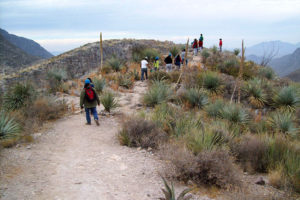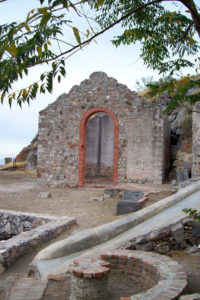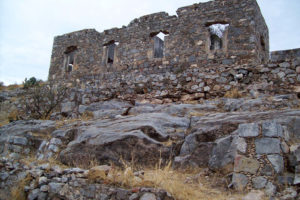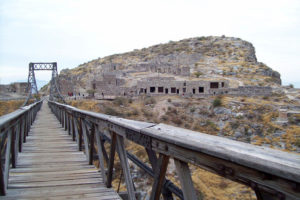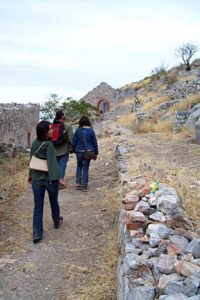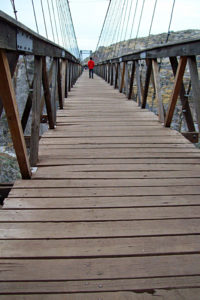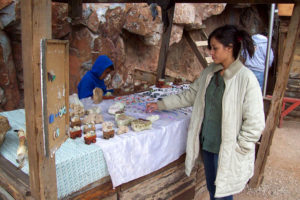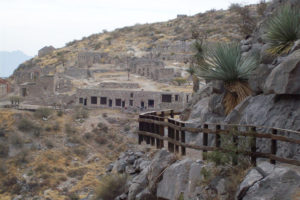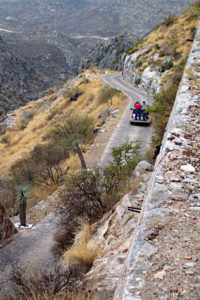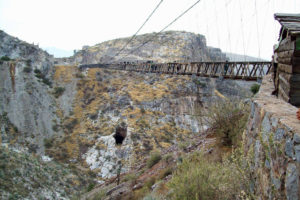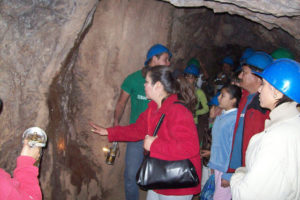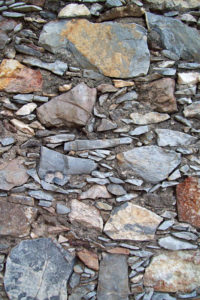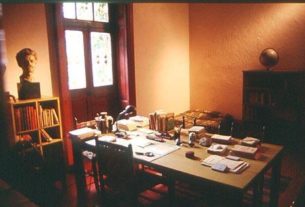In a single second, excitement, awe, terror, and fascination passed through my mind, as I began the walk across Mapimi Municipality’s Ojuela Bridge, in the Chihuahuan Desert, of eastern Durango, Mexico. The adventure began years before the sole of my shoe touched the first plank of the more than 300-meter- (990-yard-) long bridge. As exciting as it sounded from the tales of others who had visited the bridge, no one’s anecdotes compared to that first step and spending a day there with friends.
Approaching the Puente de Ojuela from any direction, Chihuahuan Desert scrub graces the landscape from the highway’s shoulder to the horizon. My day began in Gómez Palacio, with Berenice Martínez-Estrada, at the home of Javier Gustavo Valtierra-Medrano and, from there, we traveled with Gus and his girlfriend, Lupita Nava-Miranda, through Villa Juárez and into the vast desert landscape that surrounds the cities of Torreón, Gómez Palacio, and Lerdo. About an hour later, we passed though the town of Mapimi and embarked on the journey toward the Puente de Ojuela site.
Mines in Colonial Mexico
About nine kilometers from the town of Mapimi, the site’s main attraction — the suspension bridge — spans more than 300 meters. It was originally constructed in 1898 and, later, redesigned by Santiago Minguín, a German engineer. It was used to move ore from the mine across the canyon to the village of Ojuela, now in ruins. Gold and silver ore were then taken by train,to Mapimi, where it was processed. Mining activity, a guide told us, began as far back as the 16Ith Century, when Spanish prospectors discovered the precious ore. Eventually, Ojuela grew into a village, with its own post office, church, warehouses, stores, and saloons.
At the beginning of the 19th century, the Peñoles Mining Company took over the mine. Revolutionary activities and flooding later plagued the mine, and mining activities were eventually abandoned, due to recurrent flooding. We were also told that some mining activities, in the chambers nearest the surface, recently resumed, and one sees signs of modern mining on the way into the site.
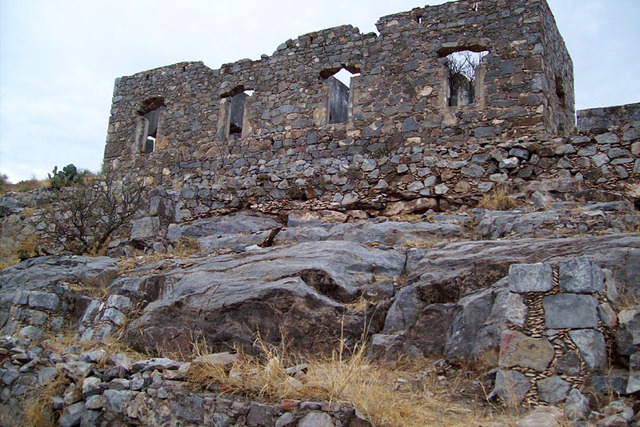
The Ojuela Ghost Town
At the entrance to the site, which encompasses not only the bridge site, but also an entire desert mountain landscape, each person pays a small fee to enter. We were cordially received and given a pamphlet on the paid activities available near the bridge. In the building at the entrance, one finds a small souvenir shop.
Passing through the entranceway, stretches a long, paved, one-lane road up to the Puente de Ojuela. The road is approximately seven kilometers (a little more than four miles) long. It crosses a desert playa and, eventually, climbs up toward the bridge site. There, one enjoys desert scenery along with evidence of past and present mining activities. We observed several visitors hiking over playas as we climbed upward.
About four kilometers (two and a half miles) from the entranceway, we met up with other visitors waiting to climb the steepest and narrowest part of the highway. There, employees of the bridge site monitor and control visitor traffic flow via radio communication. Although relatively few vehicles travel the route, a steep, climb along a single-lane cobblestone road on the rim of a deep canyon makes traffic control necessary. Although probably intimidating for city folks and tourists unaccustomed to mountain travel, the road is well-built and wide enough for even inexperienced travelers. Although we did observe a few visitors putting their vehicles in four-wheel drive, we and other visitors had no problem climbing up to the parking area in a compact car.
The ride up the mountain, through ancient slopes, is nearly as exciting as any other part of the trip, as the vehicle passes by fascinating desert plants and rock formations. The whole trip, from the entranceway to the bridge parking lot, takes no longer than 30 minutes. In our case, that included a 5 or 10 minute wait at the radio check point. Of course, suspense builds as one climbs the rocky slope toward the bridge site.
At the peak of the road, one reaches the Ojuela ghost town, where the wind whispers through skeleton ruins. Pausing as I stepped out of my vehicle, I discovered the voices of my co-travellers were drowned out by lost shouts, footsteps, clanks of rock-workers, and the crumble of compacted desert pavement beneath the feet of ghost mining families. A whole village of workers and families once inhabited and worked in the buildings now reduced to bare, rocky structures protecting empty spaces.
Shouts of excited children and observations of other visitors pulled me back to the vibrant energy of today’s tourist community, and we trekked upward, toward the main entrance of the bridge. As one walks from the parking lot to the bridge, vendors display crafts and souvenirs made from local stone, fossils, and bits of ore. Continuing onward, captivating ruins frame the rebuilt bridge. The bridge’s supporting framework has been covered with wood, simulating the structure’s original appearance, and even the exposed cables and anchors, although of a design much more modern than the original, are impressive pieces of work.
From the bridge’s starting point, one may continue onward to cross to the mine, or detour to either side to explore the ruins. We decided to take a look at shops that had been built within ruins overlooking the canyon, but found them closed on that particular day. After a look at the canyon, we headed back to the bridge. As we approached the bridge we gathered courage to step onto it and cross to the other side.
Crossing Mexico’s Ojuela Bridge
Stepping onto the bridge, again one gazes into the canyon below (or one focuses on the other side to avoid looking into the canyon), and it’s off to the other side. The bridge sways and jumps a bit, but feels surprisingly stable. Although the sides have handrails and some protective planks, spaces between the planks are wide, leaving the viewer a nearly unobstructed (and unprotected) view of the desert canyon below. The passing of tourists from the other side is also a bit intimidating, as one must move to one side or the other to allow passage. However, for anyone willing to cross, it’s an experience of a lifetime.
Arriving at the other side of the bridge, we found more vendors awaiting tourists, offering desert crafts. Railed overlooks give visitors a marvelous view of the Ojuela ghost town from the other side of the canyon, and a look into the canyon from solid ground, rather than from the suspended bridge. Also, there, one may also look into seemingly bottomless mine vents. On our visit, one of the visitors tossed a pebble into one of them, and it clicked its way downward until we could no longer hear it. Vents are uncovered and quite intimidating, but do have a protected rim where visitors can peer downward and feel the cool vent air on their faces.
And, if everything else, up to this point of the visit hasn’t been enough, part of the mine is open for guided visits. Our guide was friendly and seemed to enjoy sharing information about the mine, the ghost town, the bridge, and the history of the site. She showed us how to use lámparas de carburo (carbide lamps) before entering the mine. For anyone who’s never used one, the lamp demonstration alone makes the whole trip worthwhile! On the way into the mine, our guide told us about the mine and how miners worked there. The mine shaft that we followed, for approximately 400 m, led to a museum with historic photos, mining tools, and a petrified mule extracted from one of the mine’s mining chambers.
From there, we went onward to a smaller shaft, where my hard hat (loaned to each of the tourists) saved me from bumping my head quite a few times. The shaft lead outward, to another spectacular landscape and a distinct view of the suspended Ojuela bridge. Once we returned to our starting point, we decided to not take the zip line back across the canyon (but the option is available for adventurous tourists). We walked, instead, across the suspended bridge again… this time a little less leery and with a bit of exercise behind us.
A few sandwiches with a local cheese and extra-hot guacamole back at the car energized us, and we decided to explore the ruins a bit. We were rewarded by more surprises from the Puente de Ojuela site. Strolling through the ruins, one passes through arches where Europeans and Mexicans once talked, planned, argued, or dreamed. Climbing a rocky stairway one can nearly see a miner’s wife carrying water or his children laughing and scribbling with a broken brick on a massive stone.
I sat to replace tired camera batteries with fresh ones, and took a long moment to enjoy a massive door frame in a rock wall. The rock, painted by lichens and terrestrial algae, again, was motive to drift away from the chatter and laughter of other tourists and into the past, wondering how many sunny days had passed over these rocks. Moments later, the call of my name brought me back, and after a few photos, we were off to marvel at another apparently endless mine vent.
Crossing the bridge, walking around in the ghost town, and having lunch are enough to keep curious visitors busy all day. Even so, many tourists also find even more thrills on the zip lines that cross the canyon and a part of the parking lot. Below the line crossing the canyon, one sees desert shrubs, so far down from the line they seem like little spots on the desert pavement. The parking lot zip lines are fairly close to the ground and are a good starting point for younger adventurers.
With the sun now turning the hills orange, we found it was time to head back home. As we settled into the car, still we gazed at the beauty of the hills lining the canyon. We waited for the parking lot attendant to give us the go-ahead to follow a parade of other vehicles down the rocky highway and, again, across the desert playa. As we waited, we realized that we had walked and visited enough to leave us on the better side of exhaustion… our heads full of memories of Ojuela, its long bridge, the mine, and a desert full of buzzing life. As headlights zoomed toward and past my car, I savored my memories, and my passengers slept comfortably, maybe dreaming asleep, as I did awake.
Scariest Bridges in the World?
Is the Puente de Ojuela for anyone? Well, it is listed on a web page about the “The Scariest Bridges in the World.”
I wouldn’t classify as such. It is intimidating, and, I’ve gone over a few scarier bridges since traveling in Mexico. Even so, I would have liked to see a few planks on the bridge replaced for my next visit. Parents might want to think twice about taking hyperactive or undisciplined children across the bridge. Side rails are widely spaced, and I wouldn’t cross the bridge with just anyone.
The mine was a bit chilly and damp, but, with a sweater, it’s fine. A flashlight is also a good idea. I probably wouldn’t enter with a baby or toddler, but a healthy child able to get around on his or her own will do fine there. Walking is not too difficult. I did so with dress shoes (very dirty afterward, but I had no problems walking). Tennis shoes or boots, though, would have been much more appropriate. Physically handicapped persons would probably be limited to the drive and that which is visible from the parking lot, as the site is not accommodating to wheelchairs.
Also, bring plenty of water and take the same precautions that one should take when traveling in Mexican desert. The U.S. Department of State offers a page entitled “Tips for Travelers to Mexico” with several useful links to articles on specific topics. This page is mirrored in Access Mexico Connect at U.S. Department of State Travelers’ Tips. Also, take a look at Mexconnect’s “Camping in Mexico.”

